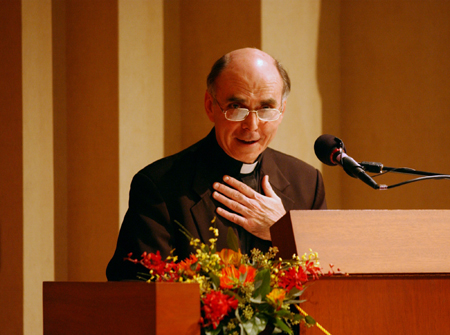Claims to antiquity

When Harvard’s founders committed themselves to a “learned ministry” for the New World, they could hardly have imagined study carrels with dataports or periodicals like Syzygy: Journal of Alternative Religion and Culture.
The newly renovated Andover-Harvard Theological Library has both, putting a 21st century face on the monastic image of the religious scholar.
“The idea of the renovation is to give people the space and the tools to maintain the tradition of excellence, learning, and research that is embodied in this school,” said J. Bryan Hehir, head of the Harvard Divinity School (HDS).
Several hundred HDS faculty, alumni, donors, and friends attended a library rededication ceremony Friday (Nov. 30) at the Academy of Arts and Sciences followed by a reception at the library itself.
Hehir gave a historical perspective of the library; architect Gail Woodhouse, M. Arch. ’80, of Amsler Woodhouse MacLean, Architects Inc., shared her design perspective on the renovation; and Richard E. Oldenburg ’54, president of the Harvard University Board of Overseers, delivered congratulatory remarks on behalf of President Lawrence H. Summers, who was unexpectedly unable to attend.
In addition, chaplain Claudia Highbaugh; Sidney Verba, Pforzheimer University Professor and director of the Harvard University Library; and Daniel Bell, Henry Ford II Professor of Social Sciences emeritus, offered contemplative and intellectual thoughts on the new space.

Linking the old with the new
First and foremost, said Woodhouse, the renovation has created much-needed space: Two new floors atop the existing library bring 12,000 square feet of new space. The $12 million project increased shelving by 40 percent and the reference area by 70 percent.
Yet the renovation of the library – the original five stories built in the early 1900s and a 1961 three-story addition – posed a loftier challenge for Woodhouse and her team. “It was understood that the second goal of this project was to reunite the library with Andover Hall, which is the heart of the Divinity School,” she said.
Toward that end, the architects replaced a former outdoor walkway with the Cloister Walk, an arched hallway that connects the hallway of Andover Hall to the new entrance of the library. Flipping through an album of before and after photos, Woodhouse points out how adding two floors to the 1961 wing visually links it to Andover Hall by uniting the buildings’ rooflines. While the renovation is modern in its materials, “it feels comfortable with the 1910 building,” she said.
Up-to-the-second technology, like flat-screen computers in study carrels, a student computing facility, and a classroom fitted with computer workstations and a passel of audiovisual equipment, exists in contrast to the stylish but downright old-fashioned reading lounges. “We invested a lot in making this a place where people would want to stay and study,” said Woodhouse.
The ancient and the modern coexist happily on the new third floor, where conservators and archivists protect fragile art and texts in skylit lofts using the latest technology. And across from the high-tech classroom, the Rabinowitz Room crowns the renovation with oak-paneled splendor.
A gift of Edwin A. Malloy ’49, LL.B. ’52, the large conference-style room lived most of its life as the office of Malloy and his father-in-law, Aaron Rabinowitz, on the 12th floor of the French Building on New York’s Fifth Avenue. Both men had a deep affection for libraries and books. Malloy donated the office to the Divinity School nearly 20 years ago; until the renovation, it was crated in storage.
Stunning in its elaborate wood detailing, the Rabinowitz Room was designed by its original occupant, Fred F. French. It features a fireplace, a carpet woven especially for the room, and stained-glass medallions from family chapels throughout Europe, some dating back to the 15th century. The Rabinowitz Room will be used “sparingly and carefully, but often,” Hehir promised.
A work in progress
When the Andover-Harvard Theological Library was built, one year after the libraries of HDS and Andover Theological Seminary merged in 1910, its five-story, fireproof stack “was said to be capable of indefinite enlargement,” Hehir told an amused audience.
Fifty years later, an addition was added to accommodate an ever-broadening collection of books and journals and needs for new services. The architects of the addition were less naïve about future expansion; the three-story building always anticipated being topped by two additional floors.
Planning and fundraising for the latest renovation began in the mid-1980s; bulldozers and hammers moved in about a year ago but the library remained open. Hehir applauded the library staff, singling out Interim Head Librarian Malcolm Hamilton, for their efforts in the face of construction. “In the course of nine months,” he said, “not one student or faculty member complained to me.”
Now, with much of the library a showplace and with heating, cooling, and humidity-control systems in place to protect its holdings, work continues on the five floors of the original 1911 wing, which will house stacks of books. Scheduled for completion in December, this final phase of the renovation will bring most of the library’s collection back on-site.
Home for a community of ideas
Yet Friday’s rededication ceremony hardly seemed premature. As guests enjoyed crudités in the periodicals stacks and listened to a string duo at the circulation desk, they admired the library’s airy layout and explored its new amenities.
“In a way, [the library] represents everything that we are about. The open mix of traditions and schools of thought that are contained here are what we argue about, agree on, and disagree on,” said Hehir, who will leave HDS at the end of December to become president and CEO of Catholic Charities USA. “This is really a community of ideas. The library is the physical and symbolic representation of those ideas.”





